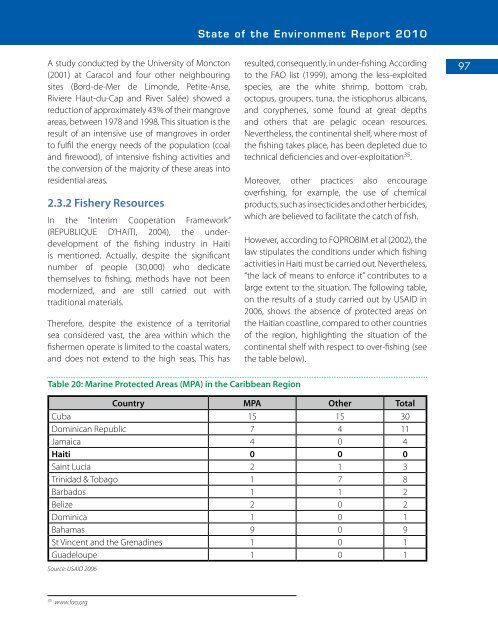GEO Haiti 2010
GEO Haiti 2010
GEO Haiti 2010
Create successful ePaper yourself
Turn your PDF publications into a flip-book with our unique Google optimized e-Paper software.
State of the Environment Report <strong>2010</strong><br />
A study conducted by the University of Moncton<br />
(2001) at Caracol and four other neighbouring<br />
sites (Bord-de-Mer de Limonde, Petite-Anse,<br />
Riviere Haut-du-Cap and River Salée) showed a<br />
reduction of approximately 43% of their mangrove<br />
areas, between 1978 and 1998. This situation is the<br />
result of an intensive use of mangroves in order<br />
to fulfil the energy needs of the population (coal<br />
and firewood), of intensive fishing activities and<br />
the conversion of the majority of these areas into<br />
residential areas.<br />
2.3.2 Fishery Resources<br />
In the “Interim Cooperation Framework”<br />
(REPUBLIQUE D’HAITI, 2004), the underdevelopment<br />
of the fishing industry in <strong>Haiti</strong><br />
is mentioned. Actually, despite the significant<br />
number of people (30,000) who dedicate<br />
themselves to fishing, methods have not been<br />
modernized, and are still carried out with<br />
traditional materials.<br />
Therefore, despite the existence of a territorial<br />
sea considered vast, the area within which the<br />
fishermen operate is limited to the coastal waters,<br />
and does not extend to the high seas. This has<br />
resulted, consequently, in under-fishing. According<br />
to the FAO list (1999), among the less-exploited<br />
species, are the white shrimp, bottom crab,<br />
octopus, groupers, tuna, the istiophorus albicans,<br />
and coryphenes, some found at great depths<br />
and others that are pelagic ocean resources.<br />
Nevertheless, the continental shelf, where most of<br />
the fishing takes place, has been depleted due to<br />
technical deficiencies and over-exploitation 35 .<br />
Moreover, other practices also encourage<br />
overfishing, for example, the use of chemical<br />
products, such as insecticides and other herbicides,<br />
which are believed to facilitate the catch of fish.<br />
However, according to FOPROBIM et al (2002), the<br />
law stipulates the conditions under which fishing<br />
activities in <strong>Haiti</strong> must be carried out. Nevertheless,<br />
“the lack of means to enforce it” contributes to a<br />
large extent to the situation. The following table,<br />
on the results of a study carried out by USAID in<br />
2006, shows the absence of protected areas on<br />
the <strong>Haiti</strong>an coastline, compared to other countries<br />
of the region, highlighting the situation of the<br />
continental shelf with respect to over-fishing (see<br />
the table below).<br />
97<br />
Table 20: Marine Protected Areas (MPA) in the Caribbean Region<br />
Country MPA Other Total<br />
Cuba 15 15 30<br />
Dominican Republic 7 4 11<br />
Jamaica 4 0 4<br />
<strong>Haiti</strong> 0 0 0<br />
Saint Lucia 2 1 3<br />
Trinidad & Tobago 1 7 8<br />
Barbados 1 1 2<br />
Belize 2 0 2<br />
Dominica 1 0 1<br />
Bahamas 9 0 9<br />
St Vincent and the Grenadines 1 0 1<br />
Guadeloupe 1 0 1<br />
Source: USAID 2006<br />
35<br />
www.fao.org

















